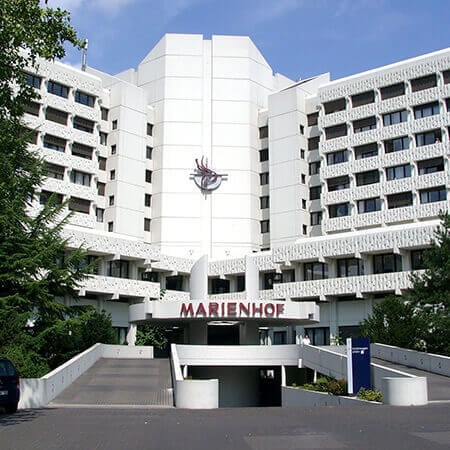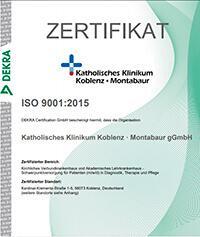Syringomyelia — Surgical treatment in the Best Hospitals in the World
Treatment prices are regulated by national law of the corresponding countries, but can also include additional hospital coefficients. In order to receive the individual cost calculation, please send us the request and medical records.

Department of Spinal Surgery
The Department of Spinal Surgery annually treats more than 590 patients with syringomyelia. The specialists use microsurgical techniques to perform shunting of cavities in the spinal cord. The surgery involves the use of the O-Arm system, which protects the spinal cord and minimizes the risk of neurological complications. The department is headed by Dr. med. A Bitter, who specializes in microsurgical spinal interventions.



Department of Spinal Surgery
The Department of Spinal Surgery at the Vivantes Auguste-Victoria Hospital all diseases of the spine - both conservatively and operatively. Patients with herniated intervertebral discs, displacement of vertebrae, stenosis of the spinal canal or back pain are treated here. In addition, specialists of the department have a unique experience in the field of complex reconstructive and revision surgeries, which are conducted to continue or correct the previous surgical treatment.


Department of Spinal Surgery
The Department of Spinal Surgery offers the full range of effective treatment methods in the area of its specialization. A highly qualified team of doctors is at the service of the department's patients, who have in their arsenal advanced conservative and surgical treatment methods for pathological changes in the spine. Spinal surgical procedures are performed in modern operating rooms, the technical equipment of which allows spinal surgeons to perfectly perform both major open surgery and sparing interventions: minimally invasive, endoscopic, and microsurgical. Surgical treatment is complemented by a carefully planned course of physiotherapy. This includes procedures such as therapeutic exercises, manual therapy, massage, osteopathic treatment, etc. The department's team of doctors consists of 10 highly qualified specialists who, together with experienced nursing staff, admit more than 1,300 inpatients annually. The medical facility is certified by the German Society for Spine Surgery (DWG) as a level II specialized center. The department's medical team makes every effort to provide each patient with optimal treatment in a pleasant and friendly atmosphere.



Syringomyelia is a congenital developmental anomaly of the spinal cord, or, less commonly, this can be an acquired defect, which is the formation of cavities with cerebrospinal fluid in the spinal cord. The disease can progress for a long time without any symptoms, but then causes pain, motor, sensory, and autonomic dysfunctions.
Content
Doctors perform craniovertebral decompression or bypass surgery to permanently drain cerebrospinal fluid.
You can seek medical attention from the the Hospital Neuwerk Moenchengladbach, the Vivantes Auguste-Viktoria Hospital Berlin, or the Catholic Clinic Koblenz-Montabaur.
You do not have to take care of organizing your treatment yourself. The specialists from the Booking Health company will help you. We will contact a hospital, make an appointment on your preferred dates, and help you prepare the necessary documents. We will also book hotel and airline tickets, meet you at the airport, and take you to the hospital by car.
How is syringomyelia treated?
The goal of treatment is to eliminate the cause and pathogenetic mechanism of syringomyelia development and ensure normal cerebrospinal fluid outflow.
Treatment is always based on surgery. Most patients undergo craniovertebral decompression or various bypass surgery options to ensure constant emptying of the contents of syringomyelic cysts so that they do not spread or enlarge and do not cause any neurological disorders.
Craniovertebral decompression
The surgical treatment of syringomyelia in most patients is performed using craniovertebral decompression. Doctors remove "unnecessary" tissues that compress brain structures. The arch of the first cervical vertebra is often removed, and sclerotic changes in the region of the transition of the skull to the spine are eliminated. As a result, the pressure on the posterior cranial fossa is reduced.
Doctors at hospitals abroad prefer more modern and sparing modifications of surgical procedures. They solve the problem of syringomyelia for a long time, if not forever. The success rate of the procedure is about 85%. The remaining 15% of patients will additionally require bypass surgery.
After craniovertebral decompression, neurological symptoms decrease, disappear, or at least stabilize. The severity and duration of symptoms influence the outcome, as the shorter the time between the onset of neurological disorders and surgery, the better the prognosis.
Bypass surgery
Spinal surgeons can implant shunts to create pathways for the cerebrospinal outflow from syringomyelic cysts into the abdominal or thoracic cavity, or the subarachnoid space. Physicians in developed countries often use endoscopic syringomyelia surgery to permanently drain cysts, which reduces the invasiveness of the intervention and reduces recovery time.
You are welcome to choose a medical care program through the Booking Health service to undergo your syringomyelia treatment abroad. Our website offers the best hospitals with spinal surgery. You can find out how much syringomyelia surgical treatment costs and compare prices at different spinal surgery departments abroad. Our specialists will help you select a hospital and arrange your trip.
Authors:
The article was edited by medical experts, board-certified doctors Dr. Nadezhda Ivanisova and Dr. Vadim Zhiliuk. For the treatment of the conditions referred to in the article, you must consult a doctor; the information in the article is not intended for self-medication!
Sources:

